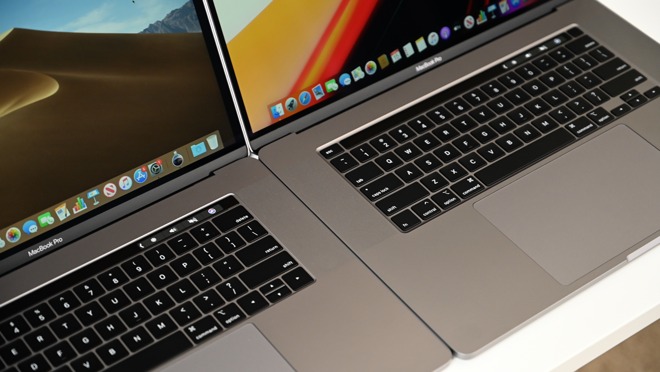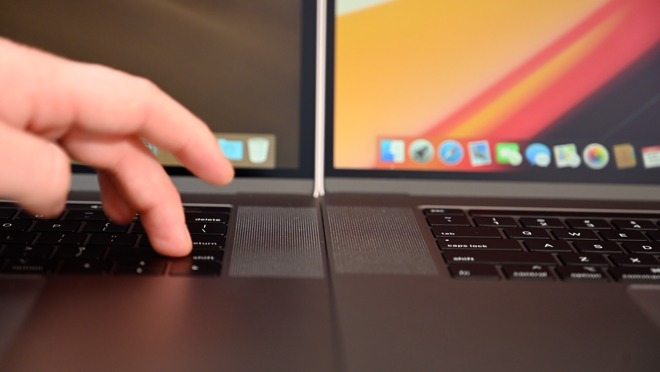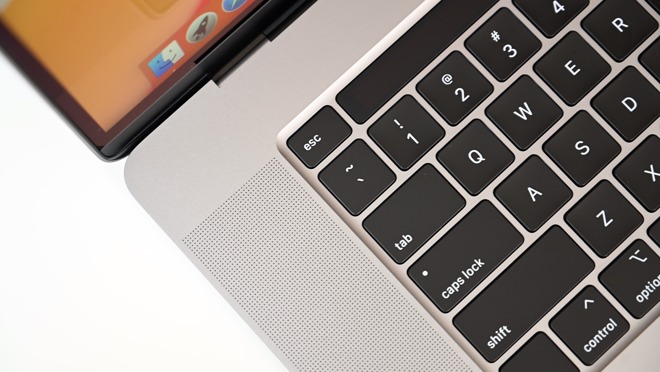Here's what the 16-inch MacBook Pro keyboard sounds like
Apple has released the 16-inch MacBook Pro to the world, after almost a year of rumors. The most obvious changes are how the keyboard feels, and what the machine sounds like in use.

Comparing the 2019 16-inch MacBook Pro (right) keyboard against the Mid-2019 15-inch MacBook Pro keybaord
So, a little context is important. We're not giant fans of typing on glass, like the iPad. We didn't have a problem with the keyboard that was introduced with the 2016 MacBook Pro -- but it wasn't a favorite of ours.
We get that the 2016 design, and iterations, are polarizing. Where the 2012 through 2015 design had the entire expression of keyboard like and hate, the 2016 through 2019 MacBook Pro weighed more heavily on the "it'll do" to "this is terrible" range.
In regards to reliability, across the entire staff, exactly one unit had to be replaced. We had the same failure rate with the 2012 through 2015 keyboard. And, the data we've been collecting on the 2018 model and the mid-2019 refresh suggests that whatever Apple did for reliability is working, with it having an equivalent failure rate in the first year to the 2012 through 2015 design.

The new 16-Inch MacBook Pro has slightly more key travel than the previous generation
Looking forward, the key actuation on the 16-inch MacBook Pro is punctuated by a soft click, most similar to the mid-2019 noise versus any other, if a bit quieter. Where the 2015 design noise was more from the key bottoming out the switch, if you press slowly, you can feel where the click is on the new computer, before hitting the bottom of the chamber. Gone is the clackety-clack of the original 2016 MacBook Pro keyboard, and you'll never mistake this keyboard for a desktop mechanical model.
There is more sensory data on the keys in the video that accompanies this piece. But, here are the numbers -- the key travel on the 16-inch MacBook Pro keyboard is one millimeter. This is in comparison to between 0.6 millimeters and 0.7 millimeters on the 2016-style keyboard, and between 1.2 millimeters and 1.5 millimeters on the 2012 through 2015 style.

Typing on the updated 16-Inch MacBook Pro keyboard
In our testing, we had a baseline of 38 DBa of ambient noise measured with a Kanomax model 4431 meter, with the test gear at head height and distance. Typing on the 2016 MacBook Pro with no other CPU load brought that up to about 43 DBa. The highest we could manage on the 16-inch MacBook Pro with a particularly angry bout of random key-mashing was 40 DBa. Quieter indeed.
With that 2016 redesign, Apple made a big deal about key stability being an underpinning of the design. In short, the new keyboard has more key travel than the 2016, but less than the 2012. Whatever Apple did for key stability in the 2016 was moved to the 16-inch MacBook Pro -- and this is a good thing.
And, Apple tells us that individual keys can be replaced. We didn't get any information on what this entails, but at this juncture, it still looks like a complete disassembly is required to do so.
Strictly from a noise standpoint, in the same 38 DBA room, the 2016 MacBook Pro under heavy load is about 45 DBa at the same range that we did the keyboard testing. The 16-inch MacBook Pro hit a maximum of 44 DBa, with equivalent fan speeds to the 2016 model.
The MacBook Pro for the last seven years has sounded about the same. It's hard to describe how it sounds now, but there is a lower pitch and a different warble to the fans now, likely because of the new blade shape. You'll notice the difference if you're a long-time user, but it isn't distracting, and you'll forget the old sound pretty quickly.

The updated keyboard includes a physical escape key
We've only just started testing thermal performance. Our initial testing suggests that the 16-inch MacBook Pro can maintain a higher clock speed for longer -- which isn't well-reflected in benchmark testing to date.
The fans on the new MacBook Pro start to get audible in that 38 DBa office environment at about 83C processor temperature. Based on observation, they start to pick up speed at about a 75C CPU temperature. a bit earlier than the 80C that the 2016 through 2019 MacBook Pro start to ramp up. We'll be testing this more in the future.
The efficacy of this thermal re-design in regards to your workflow will vary very much depending on your individual workload. But -- using a utility that turns off the boost feature on the processor essentially guarantees a silent machine with next to no fan noise, at a cost of taking about one and a half times longer to complete your job. We'll be talking about this in the future too.
Meanwhile, at B&H, shoppers can save $100 on the retail systems and select between no interest financing when paid in full within 12 months with the B&H Financing Card or a sales tax refund in eligible states with its Payboo Credit Card. The latter can save many shoppers anywhere from $200 to $500 on average.
Amazon is also offering instant discounts on the 16-inch MacBook Pro, matching B&H with prices as low as $2,299.
Be sure to check out the AppleInsider 16-inch MacBook Pro Price Guide for the latest deals and product availability on Apple's new 16-inch MacBook Pro hardware.

Comparing the 2019 16-inch MacBook Pro (right) keyboard against the Mid-2019 15-inch MacBook Pro keybaord
Apple's new MacBook Pro Keyboard
Keyboards are highly subjective. So highly subjective, that computer manufacturers have produced hundreds if not thousands of different key switches, all with different performance characteristics.So, a little context is important. We're not giant fans of typing on glass, like the iPad. We didn't have a problem with the keyboard that was introduced with the 2016 MacBook Pro -- but it wasn't a favorite of ours.
We get that the 2016 design, and iterations, are polarizing. Where the 2012 through 2015 design had the entire expression of keyboard like and hate, the 2016 through 2019 MacBook Pro weighed more heavily on the "it'll do" to "this is terrible" range.
In regards to reliability, across the entire staff, exactly one unit had to be replaced. We had the same failure rate with the 2012 through 2015 keyboard. And, the data we've been collecting on the 2018 model and the mid-2019 refresh suggests that whatever Apple did for reliability is working, with it having an equivalent failure rate in the first year to the 2012 through 2015 design.

The new 16-Inch MacBook Pro has slightly more key travel than the previous generation
Looking forward, the key actuation on the 16-inch MacBook Pro is punctuated by a soft click, most similar to the mid-2019 noise versus any other, if a bit quieter. Where the 2015 design noise was more from the key bottoming out the switch, if you press slowly, you can feel where the click is on the new computer, before hitting the bottom of the chamber. Gone is the clackety-clack of the original 2016 MacBook Pro keyboard, and you'll never mistake this keyboard for a desktop mechanical model.
There is more sensory data on the keys in the video that accompanies this piece. But, here are the numbers -- the key travel on the 16-inch MacBook Pro keyboard is one millimeter. This is in comparison to between 0.6 millimeters and 0.7 millimeters on the 2016-style keyboard, and between 1.2 millimeters and 1.5 millimeters on the 2012 through 2015 style.

Typing on the updated 16-Inch MacBook Pro keyboard
In our testing, we had a baseline of 38 DBa of ambient noise measured with a Kanomax model 4431 meter, with the test gear at head height and distance. Typing on the 2016 MacBook Pro with no other CPU load brought that up to about 43 DBa. The highest we could manage on the 16-inch MacBook Pro with a particularly angry bout of random key-mashing was 40 DBa. Quieter indeed.
With that 2016 redesign, Apple made a big deal about key stability being an underpinning of the design. In short, the new keyboard has more key travel than the 2016, but less than the 2012. Whatever Apple did for key stability in the 2016 was moved to the 16-inch MacBook Pro -- and this is a good thing.
And, Apple tells us that individual keys can be replaced. We didn't get any information on what this entails, but at this juncture, it still looks like a complete disassembly is required to do so.
The 16-inch MacBook Pro has a new cooling system, and it sounds different
Apple says that the new MacBook Pro has a completely redesigned cooling system, with different fan blades and more surface area in heat exchanging surfaces. This means that the computer sounds different under load.Strictly from a noise standpoint, in the same 38 DBA room, the 2016 MacBook Pro under heavy load is about 45 DBa at the same range that we did the keyboard testing. The 16-inch MacBook Pro hit a maximum of 44 DBa, with equivalent fan speeds to the 2016 model.
The MacBook Pro for the last seven years has sounded about the same. It's hard to describe how it sounds now, but there is a lower pitch and a different warble to the fans now, likely because of the new blade shape. You'll notice the difference if you're a long-time user, but it isn't distracting, and you'll forget the old sound pretty quickly.

The updated keyboard includes a physical escape key
We've only just started testing thermal performance. Our initial testing suggests that the 16-inch MacBook Pro can maintain a higher clock speed for longer -- which isn't well-reflected in benchmark testing to date.
The fans on the new MacBook Pro start to get audible in that 38 DBa office environment at about 83C processor temperature. Based on observation, they start to pick up speed at about a 75C CPU temperature. a bit earlier than the 80C that the 2016 through 2019 MacBook Pro start to ramp up. We'll be testing this more in the future.
The efficacy of this thermal re-design in regards to your workflow will vary very much depending on your individual workload. But -- using a utility that turns off the boost feature on the processor essentially guarantees a silent machine with next to no fan noise, at a cost of taking about one and a half times longer to complete your job. We'll be talking about this in the future too.
Save hundreds on the 16-inch MacBook Pro
Apple resellers are accepting orders for the new 16-inch MacBook Pro with a variety of incentives. Expercom is knocking up to $438 off select new configurations with coupon code appleinsider, while Adorama is taking up to $250 off retail models with promo code APINSIDER (prices start at just $2,199 with code). Details can be found in this 16-inch MacBook Pro deal roundup.Meanwhile, at B&H, shoppers can save $100 on the retail systems and select between no interest financing when paid in full within 12 months with the B&H Financing Card or a sales tax refund in eligible states with its Payboo Credit Card. The latter can save many shoppers anywhere from $200 to $500 on average.
Amazon is also offering instant discounts on the 16-inch MacBook Pro, matching B&H with prices as low as $2,299.
Be sure to check out the AppleInsider 16-inch MacBook Pro Price Guide for the latest deals and product availability on Apple's new 16-inch MacBook Pro hardware.


Comments
Looks like the trackpad is the same size isn't it?
Also, you can't really comment on the reliability yet. You can absolutely say the scissors mechanism has been more reliable in the past, but there is no way to judge the reliability of a design that has just been released. Either way, being able to service individual keys is a huge improvement over the past design.
they seem like the smallest reasons, but the butterfly was so damn noisy, like it was being bashed all the time.. and when you use something for maybe 10hrs a day it can’t be like that.
i also use the sd slot all the time, as a built in secondary drive for time machine and itunes. so now i am looking for some kind of thin usb3 to sdxc dock thing that sits flush off the mac
Else I think the Screen bezels look asymmetrical now, which looks strange at the upper corners but ok.
On that note, I bid you all adieu for 10 days. Be good.
As for the key travel, I haven't measured other machines, but I did measure 3-4 different keys on my machine and none of them had more than 0.45mm travel. I've seen other reports with similar numbers, so my machine must be 25-50% out of spec. (I tried looking up those specs and came up with nothing so I'll take your word for it.)
When talking about reliability on the 2018/19 15" MBPs I have to take it with a grain of salt. The keyboard on my 2017 has never irreparably broken, but at least a couple times a week debris causes keys to start sticking and make them close to unusable. So far I've always managed to get the key working again, so technically the keyboard has never broken. Has it given me repeated issues that compromise the use and experience? Absolutely.
what I noticed so far is even Apple Store in canada sell MBP the same price as US on sale price. Can AI confirm this?
I'm just happy they didn't return to VAG Rounded